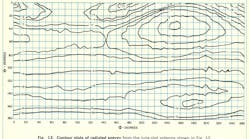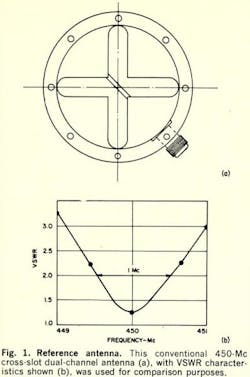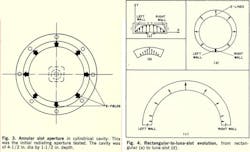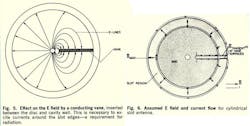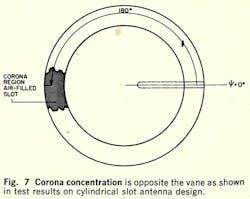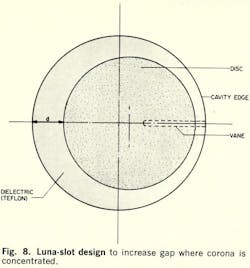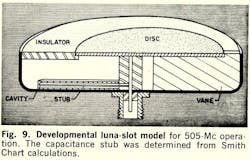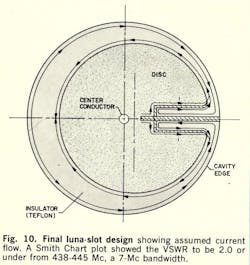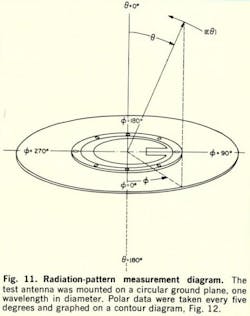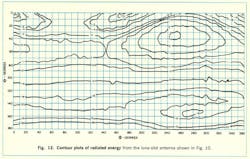Save Space with a Luna-Slot Antenna
This file type includes high resolution graphics and schematics when applicapable.
November, 1967
Historically, slot antennas have taken several shapes—rectangular, ellipse, dumbbell, bowtie, cruciform, “U,”, “H,” and annular. To prevent radiation from both sides of the slot, a backup cavity is used on one side. But, space, missile and aircraft vehicle packaging design demands that small-sized cavities and slots be used. This restrains the antenna designer because small sizes are not amenable to broadband, high-power reasonable-gain designs.
The problem is that for matched bandwidths, antenna impedance and input VSWR have a direct dependence on slot length. Also, the self-impedance of the rectangular slot is highly reactive with small real impedances if the slot length is very small in terms of wavelengths. In addition, the backup cavity will only sustain certain modes above a cutoff frequency which is dependent on the cavity internal dimensions.
Antenna impedance
An electrically short rectangular slot and a shallow backup cavity result in a high-Q antenna because of the high reactances and low resistances. These are predominant parameters that limit the bandwidth and VSWR of a basic slot antenna.
A series feed, in which the cavity becomes a transformer from the coaxial-line TEM mode, and a stretching of the slot into a lunar shape, largely overcome the described limitations. Such a feed is shown in Fig. 2, where the cavity field excitation is the radially symmetric TEM mode which has no low cutoff frequency. This is one of the modes used in the luna-slot antenna development to avoid cutoff restrictions.
A basic model was constructed of a cylindrical cavity. The resulting annular slot was used as the initial radiating aperture geometry as shown in Fig. 3. The model had a 4-1/2-in. dia, 1-1/2-in. deep cavity. A coaxial center conductor, soldered to a circular disc placed in the plane of the cavity aperture, resulted in a flush disc antenna.
Impedance measurements were made of the flush disc antenna at uhf frequencies, but because of the small sizes (relative to a wavelength) the VSWRs were exceptionally high (30:1). A re-analysis of the slot region was made using a rectangular slot-aperture analogy with its known current and field distribution. The rectangular slot was then progressively evolved into a luna-slot by stretching it into a crescent or lunar shape shown in Fig. 4. The radial asymmetry of this new geometry was also considered to fill in the null normal to the symmetrical annular slot aperture.
Antenna impedance (continued)
This file type includes high resolution graphics and schematics when applicapable.
The conducting vane was introduced between the disc and cavity wall to generate an internal E field as shown in Fig. 5. This E field excites currents around the slot edges, a necessary condition for radiation. The slot E field and current flow was then assumed to be shown in Fig. 6.
Impedance tests were made of this geometry, and VSWRs less than 2:1 over a 20-Mc band centered at 620 Mc were obtained. A Teflon dielectric disc in the plane of the slot resulted in a center frequency of 505 Mc.
The input impedance was remeasured, and the VSWR was reduced to less than 2:1 over a 6-Mc band centered at 505 Mc. A single-element shunt-capacitance stub network, placed at the junction of the input coaxial connector and the cavity, was used for matching with Smith-Chart techniques. A model of the unit is shown in Fig. 9.
Impedance tests were made, and a shunt capacitance was added using Smith-Chart data. A matched input impedance occurred from 439 to 444 Mc. Power handling tests were repeated with the unit operating satisfactorily at 17-W input at simulated altitudes in a vacuum test chamber from sea level to 280 kilofeet.
Radiation-pattern tests and conclusions
This file type includes high resolution graphics and schematics when applicapable.
Conclusions
Initial development indicates that the field distribution is similar to the rectangular slot, and the radiation patterns indicate peak gain levels which are higher than a dipole. This would indicate good efficiency.
Techniques are being investigated to further improve bandwidth and other performance characteristics with the many design parameters available. Printed-circuit and strip-line applications are also being considered to further reduce the weight, and simplify fabrication and assembly problems. Other disc and slot shapes are presently being investigated to provide useful antenna types easily adaptable to airborne vehicle structures.
References
- John D. Kraus, Antennas, (McGraw-Hill, 1950).
- Avco In-house Development Report, RAD TR-64-35.
- G.A. Bakalyar, “High Altitude Breakdown Prediction.” NASA TM-33-280.
